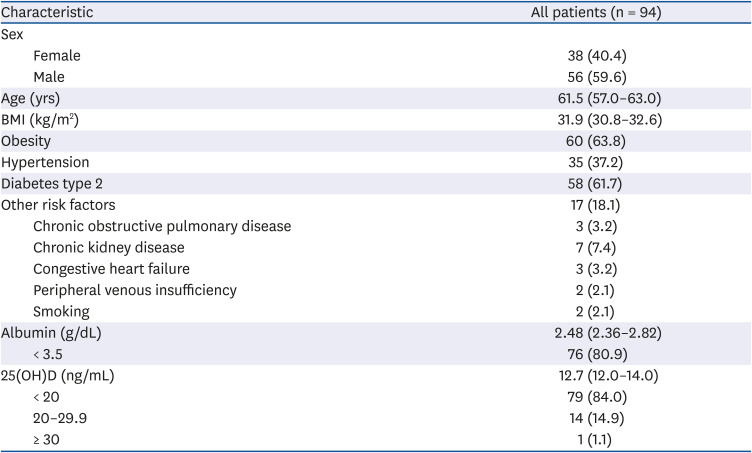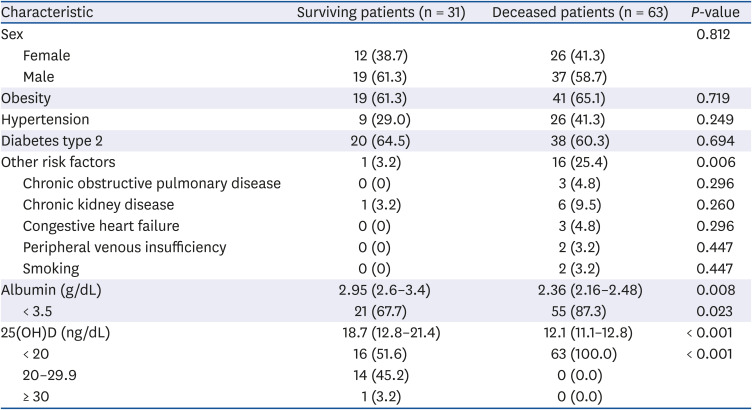1. World Health Organization (WHO). COVID-19 [Internet]. Geneva: World Health Organization;2021. cited 2021 November 3. Available from:
https://covid19.who.int/.
2. Gobierno de Mexico. Datos Abiertos Dirección General de Epidemiología [Internet]. Mexico City: Gobierno de Mexico;2021. cited 2021 November 3. Available from:
https://datos.covid-19.conacyt.mx/.
3. Epidemiology Working Group for NCIP Epidemic Response, Chinese Center for Disease Control and Prevention. The epidemiological characteristics of an outbreak of 2019 novel coronavirus diseases (COVID-19) in China. Zhonghua Liu Xing Bing Xue Za Zhi. 2020; 41:145–151. PMID:
32064853.
4. Laird E, Rhodes J, Kenny RA. Vitamin D and inflammation: potential implications for severity of COVID-19. Ir Med J. 2020; 113:81. PMID:
32603576.
5. Palacios C, Gonzalez L. Is vitamin D deficiency a major global public health problem? J Steroid Biochem Mol Biol. 2014; 144(Pt A):138–145. PMID:
24239505.

6. Contreras-Manzano A, Villalpando S, Robledo-Pérez R. Vitamin D status by sociodemographic factors and body mass index in Mexican women at reproductive age. Salud Publica Mex. 2017; 59:518–525. PMID:
29267648.

8. Greiller CL, Martineau AR. Modulation of the immune response to respiratory viruses by vitamin D. Nutrients. 2015; 7:4240–4270. PMID:
26035247.

9. Sørensen OE, Follin P, Johnsen AH, Calafat J, Tjabringa GS, Hiemstra PS, Borregaard N. Human cathelicidin, hCAP-18, is processed to the antimicrobial peptide LL-37 by extracellular cleavage with proteinase 3. Blood. 2001; 97:3951–3959. PMID:
11389039.

10. Barlow PG, Svoboda P, Mackellar A, Nash AA, York IA, Pohl J, Davidson DJ, Donis RO. Antiviral activity and increased host defense against influenza infection elicited by the human cathelicidin LL-37. PLoS One. 2011; 6:e25333. PMID:
22031815.

11. Karahan S, Katkat F. Impact of serum 25(OH) vitamin D level on mortality in patients with COVID-19 in Turkey. J Nutr Health Aging. 2021; 25:189–196. PMID:
33491033.

12. De Smet D, De Smet K, Herroelen P, Gryspeerdt S, Martens GA. Serum 25(OH)D level on hospital admission associated with COVID-19 stage and mortality. Am J Clin Pathol. 2021; 155:381–388. PMID:
33236114.

13. Alguwaihes AM, Al-Sofiani ME, Megdad M, Albader SS, Alsari MH, Alelayan A, Alzahrani SH, Sabico S, Al-Daghri NM, Jammah AA. Diabetes and COVID-19 among hospitalized patients in Saudi Arabia: a single-centre retrospective study. Cardiovasc Diabetol. 2020; 19:205. PMID:
33278893.

14. Amrein K, Scherkl M, Hoffmann M, Neuwersch-Sommeregger S, Köstenberger M, Tmava Berisha A, Martucci G, Pilz S, Malle O. Vitamin D deficiency 2.0: an update on the current status worldwide. Eur J Clin Nutr. 2020; 74:1498–1513. PMID:
31959942.

15. Sassi F, Tamone C, D’Amelio P. Vitamin D: Nutrient, Hormone, and Immunomodulator. Nutrients. 2018; 10:1656.

16. Hewison M. Antibacterial effects of vitamin D. Nat Rev Endocrinol. 2011; 7:337–345. PMID:
21263449.

17. Hansdottir S, Monick MM, Hinde SL, Lovan N, Look DC, Hunninghake GW. Respiratory epithelial cells convert inactive vitamin D to its active form: potential effects on host defense. J Immunol. 2008; 181:7090–7099. PMID:
18981129.

18. Vanherwegen AS, Gysemans C, Mathieu C. Regulation of immune function by vitamin D and its use in diseases of immunity. Endocrinol Metab Clin North Am. 2017; 46:1061–1094. PMID:
29080635.

19. Hewison M. Vitamin D and the immune system: new perspectives on an old theme. Endocrinol Metab Clin North Am. 2010; 39:365–379. PMID:
20511058.

20. Grant WB, Lahore H, McDonnell SL, Baggerly CA, French CB, Aliano JL, Bhattoa HP. Evidence that vitamin D supplementation could reduce risk of influenza and COVID-19 infections and deaths. Nutrients. 2020; 12:988.

21. Brito A, Cori H, Olivares M, Fernanda Mujica M, Cediel G, López de Romaña D. Less than adequate vitamin D status and intake in Latin America and the Caribbean: a problem of unknown magnitude. Food Nutr Bull. 2013; 34:52–64. PMID:
23767281.

22. Carrillo-Vega MF, García-Peña C, Gutiérrez-Robledo LM, Pérez-Zepeda MU. Vitamin D deficiency in older adults and its associated factors: a cross-sectional analysis of the Mexican Health and Aging Study. Arch Osteoporos. 2017; 12:8. PMID:
28028727.

23. Mendes MM, Hart KH, Botelho PB, Lanham-New SA. Vitamin D status in the tropics: is sunlight exposure the main determinant? Nutr Bull. 2018; 43:428–434.

24. Norval M, Wulf HC. Does chronic sunscreen use reduce vitamin D production to insufficient levels? Br J Dermatol. 2009; 161:732–736. PMID:
19663879.

25. Brenner M, Hearing VJ. The protective role of melanin against UV damage in human skin. Photochem Photobiol. 2008; 84:539–549. PMID:
18435612.

26. Vranić L, Mikolašević I, Milić S. Vitamin D deficiency: consequence or cause of obesity? Medicina (Kaunas). 2019; 55:541.

27. Chang SW, Lee HC. Vitamin D and health - The missing vitamin in humans. Pediatr Neonatol. 2019; 60:237–244. PMID:
31101452.

28. López-Feldman A, Heres D, Marquez-Padilla F. Air pollution exposure and COVID-19: a look at mortality in Mexico City using individual-level data. Sci Total Environ. 2021; 756:143929. PMID:
33302074.

29. Wang H, Chen W, Li D, Yin X, Zhang X, Olsen N, Zheng SG. Vitamin D and chronic diseases. Aging Dis. 2017; 8:346–353. PMID:
28580189.

30. Docherty AB, Harrison EM, Green CA, Hardwick HE, Pius R, Norman L, Holden KA, Read JM, Dondelinger F, Carson G, et al. Features of 20 133 UK patients in hospital with covid-19 using the ISARIC WHO Clinical Characterisation Protocol: prospective observational cohort study. BMJ. 2020; 369:m1985. PMID:
32444460.
31. Rezende LF, Thome B, Schveitzer MC, Souza-Júnior PR, Szwarcwald CL. Adults at high-risk of severe coronavirus disease-2019 (Covid-19) in Brazil. Rev Saude Publica. 2020; 54:50. PMID:
32491091.

32. Martínez-Zavala N, López-Sánchez GN, Vergara-Lopez A, Chávez-Tapia NC, Uribe M, Nuño-Lámbarri N. Vitamin D deficiency in Mexicans have a high prevalence: a cross-sectional analysis of the patients from the Centro Médico Nacional 20 de Noviembre. Arch Osteoporos. 2020; 15:88. PMID:
32542548.

33. Acharya R, Poudel D, Bowers R, Patel A, Schultz E, Bourgeois M, Paswan R, Stockholm S, Batten M, Kafle S, et al. Low serum albumin predicts severe outcomes in COVID-19 infection: a single-center retrospective case-control study. J Clin Med Res. 2021; 13:258–267. PMID:
34104277.

34. Munshi R, Hussein MH, Toraih EA, Elshazli RM, Jardak C, Sultana N, Youssef MR, Omar M, Attia AS, Fawzy MS, et al. Vitamin D insufficiency as a potential culprit in critical COVID-19 patients. J Med Virol. 2021; 93:733–740. PMID:
32716073.

35. Vassiliou AG, Jahaj E, Pratikaki M, Orfanos SE, Dimopoulou I, Kotanidou A. Low 25-hydroxyvitamin D levels on admission to the intensive care unit may predispose COVID-19 pneumonia patients to a higher 28-day mortality risk: a pilot study on a Greek ICU cohort. Nutrients. 2020; 12:3773.

36. Allegra A, Tonacci A, Pioggia G, Musolino C, Gangemi S. Vitamin deficiency as risk factor for SARS-CoV-2 infection: correlation with susceptibility and prognosis. Eur Rev Med Pharmacol Sci. 2020; 24:9721–9738. PMID:
33015818.
37. Cano F, Gajardo M, Freundlich M. Renin angiotensin axis, angiotensin converting enzyme 2 and coronavirus. Rev Chil Pediatr. 2020; 91:330–338. PMID:
32730512.
38. Catanzaro M, Fagiani F, Racchi M, Corsini E, Govoni S, Lanni C. Immune response in COVID-19: addressing a pharmacological challenge by targeting pathways triggered by SARS-CoV-2. Signal Transduct Target Ther. 2020; 5:84. PMID:
32467561.

39. Martineau AR, Jolliffe DA, Hooper RL, Greenberg L, Aloia JF, Bergman P, Dubnov-Raz G, Esposito S, Ganmaa D, Ginde AA, et al. Vitamin D supplementation to prevent acute respiratory tract infections: systematic review and meta-analysis of individual participant data. BMJ. 2017; 356:i6583. PMID:
28202713.









 PDF
PDF Citation
Citation Print
Print



 XML Download
XML Download